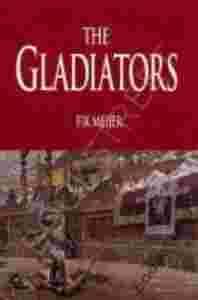|
Superfit, muscled, macho, the gladiator was
hero-worshipped for his skill and courage as he fought
to the death, yet despised for his humble status. For
over six cruel centuries, ten or thousands died in the
bloodsoaked arenas of Rome and its colonies, watched by
enthralled crowds, screaming for violence. Drawn from
prisoners of war, slaves, convicts and in later
centuries, Roman citizens fighting for money and
excitement, the gladiators lived inside gladiator
schools where they trained in special fighting
techniques: the 'retiarius' with net and trident, the
'thraex' with short sword and round shield, the
'secutor' , the 'murmillo', the 'hoplomachus'. Few lived
to old age or found freedom again. Fewer still lived to
tell their tale. Professor Fik Meijer has ingeniously
pieced together their true stories from grave epitaphs,
graffiti, mosaic, frescoes and engravings, from
artefacts found under the ashes of Pompeii, and
quotations from ancient Romans writers, as well as his
close study of Greek and Etruscan history. He describes
the gladiators' origins, daily life, training, the odds
of their survival pitted against the emperors' lust for
blood and spectacle. He illustrates the vast, complex
organisation and expense incurred in staging the shows.
Tracing the origins of the gladiators over 2,500 years,
from the initial belief that their blood spilled on a
grave wound sustain the death on its journey to the
underworld. Yet, as centuries passed and the Roman
Empire grew gladiators became part of the vaster, more
brutal entertainments, staged by successive emperors
eager to manipulate the public with 'bread and circuses'
and eager to exhibit their supreme power over men and
animals, life and death. As more and more grandiose
performances were staged, the Colosseum was built and
copied all over the Roman Empire, and the extravagant
spectacles became daylong. The morning show began with
the 'hunting' of wild animals, sometimes in their
thousands, followed by wild animal fights; bear against
bull or captured slaves, Christian against crocodiles,
lion, tigers, hippopotamuses even, all shipped from
Rome's African colonies. At lunchtime came the public
executions; death by sword, burning at the stake,
crucifixions, and in the afternoon the long awaited,
much applaud gladiators fights, the day s may
attraction. There were even sea battles where the great
arenas were flooded. Professor Meijer brings these
events vividly to life, and ends his fascinating book by
comparing the real evidence he has uncovered with
portrayals in films such as "Spartacus" and "Gladiator"
. |
|

